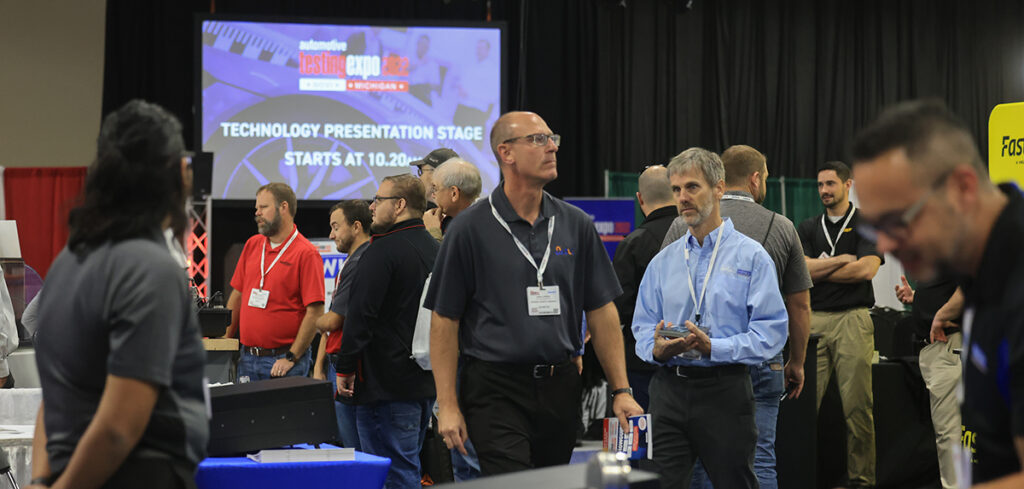Automotive Testing Expo kicked off yesterday (Tuesday) at the Suburban Collection Showplace in Novi, Michigan, marking the return to a full-capacity, full-size show with person-to-person discussions and physical demonstrations. The show runs until Thursday, October 27 and is completely free to attend.
The show features an Autonomous Vehicle Technologies Zone, which is dedicated to test and next-generation enabling technologies and solutions, while a further 100+ ADAS/AV exhibitors within the adjoining Automotive Testing Expo hall are helping advise on and accelerate test and validation programs.
The free-to-attend Technology Presentation Stage, which runs alongside the three-day exhibition, features expert speakers from leading OEMs and Tier 1 and 2 suppliers covering the latest ADAS and AV testing protocols, procedures and solutions that will help move the industry toward the next stage of semi- and fully autonomous vehicle implementation and enable smarter and safer vehicles.
The first day saw new launches and cutting-edge technology across the AVT Zone. Here are a few highlights…
ACM reveals more about Michigan’s first modular hydrogen production system
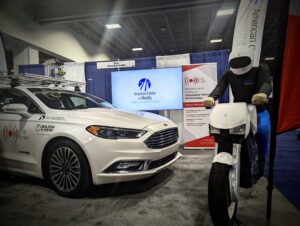 The American Center for Mobility is sharing its capabilities and development plans for testing and validating CAV transportation systems.
The American Center for Mobility is sharing its capabilities and development plans for testing and validating CAV transportation systems.
“Today, with its large-scale configurable road infrastructure, state-of-the-art connectivity, data management and R&D support, American Center for Mobility is the premier center for testing and validation of CAV transportation systems,” said Sushanta Das, ACM technical director, live at the show. “We have taken a big step ahead toward EV fast charging, AV testing, cybersecurity and hydrogen fuel cell to meet our clients’ needs for tomorrow.”
As ACM looks to adapt its vision to the needs of its customers, a modular hydrogen production system is being planned. “The modular hydrogen production system will initially produce 1-2 tons per day and can be delivered by BayoTech to customers within a 100- to 200-mile radius,” revealed Reuben Sarkar, ACM president & CEO.
He continued, “Hydrogen fuel cells have an electrified powertrain. They are essentially fuel cell electric vehicles with the electrons coming from H2 instead of the grid. Hydrogen can also be used in advanced combustion engines and can help decarbonize certain segments of transportation such as medium- or heavy-duty vehicles that are harder to convert to battery electric alone. Hydrogen is a fast fill technology with refueling rates more comparable to gas or diesel, and you don’t have to carry a large battery for longer ranges. Trucking is a main focus today and it could be used to decarbonize port vehicles as well as rail and marine in the future.”
Kevin Kelly, director of sales, added, “ACM collaborates with key partners, and for this year’s show VSI Labs and ACM decided to exhibit together due to our existing testing relationship, which has been going on over the past few years. ACM & VSI Labs are always looking to gain additional partners and collaborators, and Automotive Testing Expo is the perfect stage to research and extend our mutual innovations with other potential technology-advanced companies.”
ACM is also using Automotive Testing Expo to share that earlier this month, on October 13, Delta demonstrated a 400kW Solid State Transformer-based Extreme Fast EV Charger to its partners, GM, DTE Energy, NextEnergy, Virginia Tech’s CPES, American Center for Mobility and US DOE.
Delta Electronics (Americas) Ltd or ‘Delta Americas’, subsidiary of Delta Electronics, Inc (‘Delta’), a global leader in power and thermal management technologies and provider of smart energy-saving solutions, demonstrated a next-generation SiC MOSFET solid state transformer (SST)-based 400kW extreme fast EV charger to its US DOE grant program partners General Motors (GM), DTE Energy, NextEnergy, Virginia Tech’s Center for Power Electronics Systems (CPES), and the American Center for Mobility. At the event, key representatives from all program partners, shared their vision on how Delta’s extreme fast EV charging solution, which facilitates industry-leading charging current up to 500 Amps, is expected to accelerate the adoption of e-mobility across North America. The demonstration event featured GM’s all-electric supertruck, the GMC HUMMER EV.
Sarkar added, “ACM is also looking to better capitalize on the industry’s accelerated transition to EVs by offering more electrification testing services.”
Booth: AV206
aiMotive demonstrates its cloud-based testing and validation tool
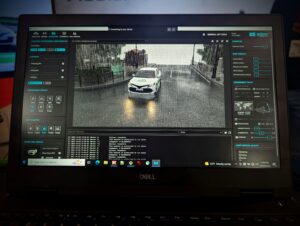 aiMotive is showing visitors the latest generation of aiSim, the world’s first ISO 26262-certified simulator. According to Bence Boda, the company’s marketing and communications manager, safety is the most critical ADAS and AD software development principle. Speed and cost of development are also crucial driving forces. “One needs an automotive-grade toolchain to address all these aspects of ADAS and AD software development,” explained Bence. “With ISO 26262, such toolchain providers are certified to comply with the automotive development and testing processes.
aiMotive is showing visitors the latest generation of aiSim, the world’s first ISO 26262-certified simulator. According to Bence Boda, the company’s marketing and communications manager, safety is the most critical ADAS and AD software development principle. Speed and cost of development are also crucial driving forces. “One needs an automotive-grade toolchain to address all these aspects of ADAS and AD software development,” explained Bence. “With ISO 26262, such toolchain providers are certified to comply with the automotive development and testing processes.
“aiSim is a purpose-built testing and validation tool for AD and ADAS software development. The proprietary rendering engine ensures a physics-accurate, deterministic operation that overcomes the limitations of non-deterministic gaming engine-based simulators. As the AV industry requires credible and reproducible results, ISO 26262-certified tools have an inherent USP in the automotive industry.
“aiSim’s essence is its purpose-built rendering engine, which ensures deterministic operation with verified results. At the same time, it helps meet the demand for highly realistic sensor simulation to achieve the highest-possible correlation between real-world and simulated tests. Its operation is based on realistic sensor simulation through physically correct weather simulation and procedurally generated light intensity. aiSim is designed to be a simulation platform that can be easily integrated into existing development pipelines.
“With ADAS and AD software becoming a remarkable piece of the automotive industry, the demand for scalable testing increases significantly. Cloud-based simulation can help meet this ever-increasing demand while making it easy for stakeholders to execute large-scale simulations in the cloud.
“More and more stakeholders in the automotive industry recognize the value of the simulation to develop, test and validate ADAS and AD systems. Moreover, the regulation is also going in the direction of virtual validation. Consequently, simulation is increasingly becoming an integral part of the AV industry.
“Since aiSim was developed in-house from the start for validating and testing self-driving systems, we chose the Autonomous Vehicle Technology Zone. Automotive manufacturers and their suppliers are our primary target group.”
Niall Berkery, aiMotive’s SVP North America, said at the show, “We’re exhibiting in the Autonomous Vehicle Technology Zone as the overall audience on the testing, validation and proving side is very applicable for us.”
Booth: AV302
Monolith presentation: How BMW uses AI to accelerate crash tests
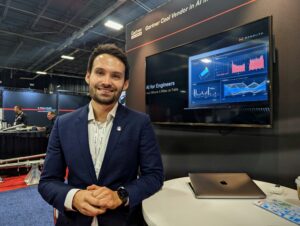 Day 1 of Automotive Testing Expo saw Dr Richard Ahlfeld, CEO at Monolith, give a presentation on How BMW uses AI to accelerate crash tests at the Technology Presentation Stage.
Day 1 of Automotive Testing Expo saw Dr Richard Ahlfeld, CEO at Monolith, give a presentation on How BMW uses AI to accelerate crash tests at the Technology Presentation Stage.
Ahlfeld revealed how, using Monolith’s no-code AI crash testing software, BMW Group engineers built self-learning models using existing crash data and were able to accurately predict the force on the tibia for a range of different crash types without doing physical crashes. This game-changing approach will enable engineers to reduce physical tests and cut product development time by 50%.
Ahlfeld explained that the Monolith AI crash testing platform was developed with a laser focus on user experience by automotive experts and data scientists to ensure seamless integration with existing engineering processes.
“By adopting data-driven methods and self-learning models, engineers can optimize crash performance earlier in the design process and reduce dependence on time-intensive, costly testing whilst making historical data infinitely more valuable,” he said.
“The accuracy of the self-learning models will continue to improve as more data becomes available and the platform is further embedded into BMW’s engineering workflow and functions across R&D that generate vast amounts of data from crash testing to aerodynamics, motorsports and advanced driver-assist systems [ADAS].”
Ahlfeld continued, “We’re in Detroit to share the results of our work with BMW and share ideas on the future of engineering – namely the role of AI. We’re looking forward to expanding our network and further understanding the needs of engineers. We had a great experience at Automotive Testing Expo Stuttgart so look forward to more of the same.”
Monolith is also sharing its swarming technology on the exhibition floor.
Booth 15036
Technology Presentation Stage: Autonomous Solutions demonstrates robotic choreographed testing for ADAS/AVs
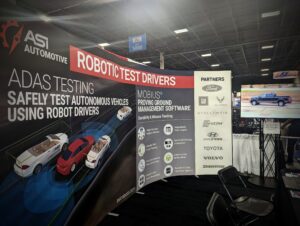 Jed Judd, automotive product manager at Autonomous Solutions Inc (ASI), talked about Robotic choreographed testing for ADAS/AVs on the Technology Presentation Stage.
Jed Judd, automotive product manager at Autonomous Solutions Inc (ASI), talked about Robotic choreographed testing for ADAS/AVs on the Technology Presentation Stage.
Judd revealed how, alongside a world-leading OEM, ASI has developed autonomous technology capable of choreographed testing of ADAS/AV systems. The company calls this technology Swarming.
Driven by robotic systems, autonomous vehicles are capable of tighter, more accurate positioning than manned vehicles can safely perform. Swarming uses vehicle-to-vehicle and vehicle-to-server communications with advanced control algorithms, ensuring autonomous vehicles will be posed at predefined positions and velocities at given times. The technology fully exercises the responses of the entire ADAS/AV systems required for autonomous driving. When triggered, Mobius – ASI’s command and control software — releases control to the ADAS/AV system while continually monitoring safety, ready to regain control instantly if conditions are not nominal.
Jaren Devey, ASI’s automotive development manager, said, “We realize that testing high-speed collision anticipation and avoidance is simply too dangerous for human drivers, yet the need for this is now. Our solution is to use robot drivers during these dangerous testing phases, so that OEMs can test their vehicles to the extreme limits of their engineering while ensuring the safety of everyone involved.”
ASI reveal that this robotic system is already giving value in durability, misuse, impact, noise and vibration, ADA/AV systems, and more use cases.
According to Judd, ASI has attended Automotive Testing Expo North America for several years and has found it to be a great place to showcase the advantages of using robotic test drivers on proving grounds for OEMs and Tier suppliers. The company looks forward to meeting more potential customers and exploring how its solutions can help solve their use cases.
The company is also showcasing its technologies on the exhibition floor. Visit the ASI booth to find out more.
Booth: 6024


